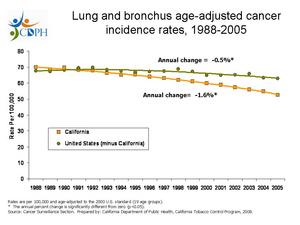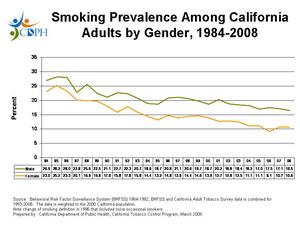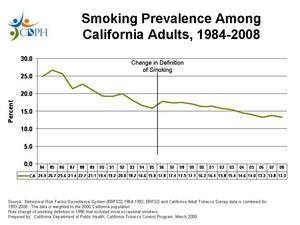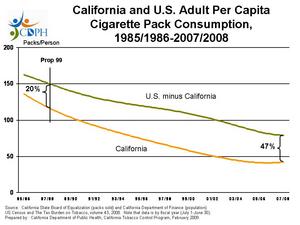California's Award-Winning Tobacco Control Program Marks Its 20th Anniversary
State Releases Data Showing Smoking Rates in California Continue to Decline as Calls to the State's Quit Line Reach Record Highs
| Source: California Department of Public Health
SACRAMENTO, CA--(Marketwire - April 7, 2009) - California's world renowned tobacco control
program celebrated its 20th anniversary today by releasing data that show
tobacco use continuing to decline. The anniversary comes as calls to the
"1-800 No Butts" quit line are up 25 percent from the same period last
year.
California Department of Public Health (CDPH) data show that, since the
inception of the state's tobacco control program, overall adult smoking
rates in California have decreased 41 percent, from 22.7 percent in 1988 to
13.3 percent in 2008, and overall per person cigarette consumption rates
have decreased 67 percent. In 2008, the youth smoking rate declined to 14.6
percent, one of the lowest rates in the nation.
"It is estimated that efforts undertaken by the state's tobacco control
program over the last 20 years have saved more than 1 million lives in
California and have resulted in $86 billion worth of savings in health care
costs," said Kimberly Belshé, secretary of California's Health and Human
Services Agency. "California's successful tobacco control efforts have
worked to change the social norms around the use of tobacco to create an
environment in which tobacco is less acceptable."
California users of tobacco products continue to rely on state programs to
assist with quitting, including the state's telephone quit line.
For the first three months of this year, from the beginning of January to
end of March, there were 11,067 calls to the quit line, up 25 percent from
calls in the same period of 2008. Over the last 17 years, the California
Smokers' Helpline has counseled nearly half a million people. Today,
residents in all 50 states have access to telephone counseling based on the
California model.
"California was the early leader in tobacco control efforts, including
being the first state to establish a free, telephone counseling program to
help people who are ready to quit using tobacco," said Dr. Mark Horton,
director of CDPH, the department that leads the California Tobacco Control
Program. "Today the California Smokers' Helpline is receiving a record
number of calls, as more and more Californians make the decision to quit."
When California initiated the tobacco control program in 1988, tobacco use
was commonplace:
-- Health care providers could smoke while working in emergency rooms and
in hospitals during patient exams;
-- Teachers could smoke in hallways between classes and schools often had
smoking areas for students;
-- All Californians faced exposure to secondhand smoke in restaurants,
bars, on buses and in the workplace.
California has continually broken new ground through local policies and
statewide laws restricting smoking that have reverberated throughout the
world.
California was the first state to prohibit smoking on trains, planes,
buses, public buildings, workplaces, restaurants and bars. Most recently,
in 2008, California implemented a statewide law prohibiting smoking in a
moving or parked car when a minor is present.
The 20 years of anti-smoking efforts have resulted in:
-- Improved health outcomes -- with significantly faster declines in lung
cancer rates and lower incidence rates in six out of nine cancer types that
are linked to tobacco use in California compared to the rest of the U.S.;
-- A decline in the adult smoking prevalence rate from 22.7 percent in
1988 to 13.3 percent in 2008; and
-- More than one million lives saved, along with $86 billion dollars in
health care costs.
"While we are proud of the impact this campaign has had on California, we
know we have more work to do. The tragic fact is that the tobacco industry
still continues to market its deadly product to young people," said Dr.
Mark Horton. "We must continue our strong assault on the number one
preventable cause of disease and death."
California's tobacco control program continues to engage the public in new
and unique ways to broaden the reach of its powerful public health
messages. Among other initiatives, last year, the program partnered with
all of the major motion picture studios to place California's anti-smoking
television commercials on millions of youth-rated DVD movies that contain
images of smoking.
The California Tobacco Control Program was established by the Tobacco Tax
and Health Promotion Act of 1988, was approved by California voters,
instituting a 25-cent tax on cigarettes and earmarking 5 cents of every
cigarette pack sold to fund California's tobacco control efforts. To learn
more about California's tobacco control program visit www.cdph.ca.gov or
www.TobaccoFreeCA.com.




